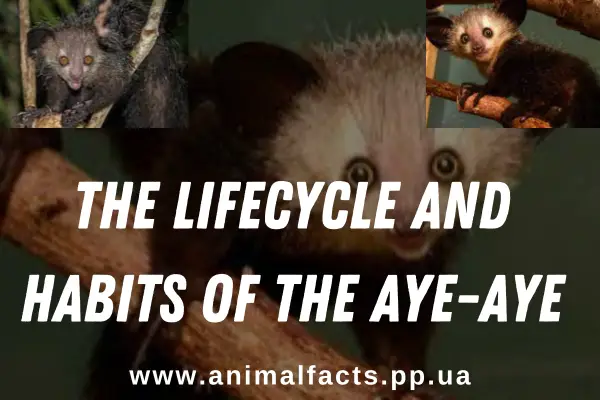Aye-Aye
The aye-aye (Daubentonia madagascariensis) is a highly unique primate found only on the island of Madagascar. As the world’s largest nocturnal primate, the aye-aye has a number of distinctive features and behaviors. Here is an overview of the aye-aye’s fascinating lifecycle and habits.
Lifecycle
The aye-aye can live up to 23 years in the wild. Females reach maturity at around 2-3 years old, while males take a bit longer at 3-4 years. Aye-ayes breed year round, though most mating takes place between February and May.
After a gestation period of 160-170 days, the female gives birth to a single infant. Newborn aye-ayes are very underdeveloped; their eyes are closed and they are unable to stand or cling to their mothers. Instead, they are nestled inside a nest in a tree hollow by their mother for the first 2-3 months.
At 2-3 months old, the infant aye-aye opens its eyes and begins to explore its surroundings. It starts to accompany its mother on foraging trips at around 5 months old. By 1 year old, the infant is fully weaned from its mother. Males and females reach full maturity by around 3-4 years old.
Unique Adaptations
The aye-aye has evolved a number of special physical features and behaviors to thrive as a nocturnal rainforest primate. Some of their most distinctive adaptations include:
1- Large, bat-like ears to enhance hearing
2- Long, thin middle finger used for tapping trees to find insects and extract the larvae
3- Specially adapted incisors that are continually growing and are used for gnawing into wood
4- Excellent night vision from huge eyes to see in the dark
5- Dense coat of shaggy black or brown fur to provide warmth in cold nights
6- Solitary lifestyle, foraging alone at night and nesting alone during the day
Feeding Habits
The aye-aye is an omnivore, with an eclectic diet including insects, fungi, seeds, nectar, and even small birds or mammals. Their main food source is beetle larvae, which they extract from inside dead trees. The aye-aye uses its long middle finger to tap dead trees and listen for cavities where larvae might be present.
Once a cavity is detected, the aye-aye then uses its chisel-like incisors to gnaw a hole in the wood. It extracts the larvae with its long finger, which is specially adapted with a ball-and-socket joint. The aye-aye also uses this method to extract the fleshy seeds of the traveller’s tree.
Habitat and Conservation
The aye-aye exclusively lives in rainforest habitats in the eastern and northern parts of Madagascar. These forests provide the large trees they rely on for nesting, shelter, and food. However, due to deforestation, the aye-aye’s habitat has been dramatically reduced.
The aye-aye has been listed as Endangered by the IUCN Red List since at least the 1990s. Besides habitat loss, they are also threatened by superstition and hunting. Some natives consider the aye-aye a harbinger of evil, and will kill them on sight.
Conservation efforts are focused on protecting the remaining intact rainforest habitat through the establishment of national parks and reserves. Ecotourism efforts to see the unique aye-aye may also help provide economic incentives to protect their habitat. More education is also needed to combat superstitions about this highly distinctive nocturnal primate.
The aye-aye remains little known due to its nocturnal and solitary habits deep within the Madagascan rainforest. But their unique adaptations showcase the remarkable diversity of Madagascar’s wildlife. Learning more about the aye-aye’s lifecycle and habits can help shed light on this rare and fascinating primate.
FAQs:
Q: Where does the aye-aye live?
A: The aye-aye is endemic to the island of Madagascar. It is found in rainforest habitats on the eastern and northern parts of the island.
Q: What does the aye-aye eat?
A: The aye-aye is omnivorous and eats a wide variety of foods. Their main food source is beetle larvae, which they extract from dead trees. They also eat fungi, seeds, nectar, and occasionally small vertebrates.
Q: Why does the aye-aye tap on trees?
A: The aye-aye uses its long middle finger to tap on dead trees and listen for hollow chambers that might contain insect larvae. Once it detects a cavity, it gnaws a hole with its teeth to extract the larvae.
Q: What are the aye-aye’s unique adaptations?
A: Adaptations include large bat-like ears, a long thin middle finger for tapping, continually growing incisors for gnawing, excellent night vision, and a shaggy coat to stay warm at night.
Q: Is the aye-aye endangered?
A: Yes, the aye-aye is listed as Endangered by the IUCN Red List. Deforestation and hunting have dramatically reduced its population.
Q: Why do some people think the aye-aye is evil?
A: Some Malagasy people consider the aye-aye a harbinger of evil and will kill them on sight. This superstition contributes to their endangered status.
Q: What is being done to protect the aye-aye?
A: Conservation efforts include protecting rainforest habitat, establishing reserves, promoting ecotourism, and educating people to reduce superstitions.
Q: How big is an aye-aye?
A: The aye-aye is about the size of a large house cat. They are typically 2.5-3 feet long and weigh around 5-6 pounds.
Q: What is the aye-aye’s conservation status?
A: The aye-aye is classified as Endangered by the IUCN Red List and CITES. Its population is decreasing.

